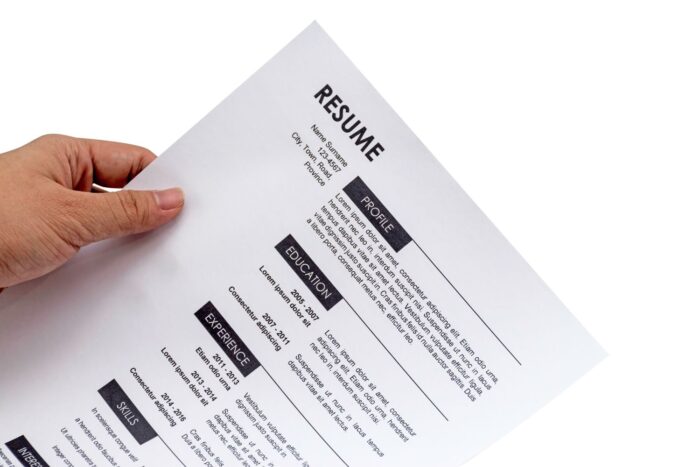An important part of a resume is the fonts you choose to use. This introduction will cover the basics of what to look for when searching for fonts in your career goals.
However, there are so many fonts! And with so many fonts, it’s hard to know which font is best for your resume.
The font on your resume should be easy to read. The background color of your resume should complement the typeface of your words. Fonts in the serif family are good because they traditionally have smaller spacing between letters and smaller curves than other letters, making them easier to read. If you want to get more tips, visit resumewritingservices.org
Different Fonts and Why They Matter
Serif: Serif fonts have longer vertical lines on letters. Sans serif: Sans serif fonts do not have long vertical lines on letters. Monospaced: Monospaced fonts are the same width for every letter in a word. Proportionally spaced: Proportionally spaced fonts vary between different letters in a word. If you see a capital letter at the beginning of a sentence, it has small marks that make the first letter different from the rest of the word. For example, look at how ‘R’ is taller than ‘upon these small marks. Furthermore, look at how the capitals don’t have small marks. In these ways, you can easily tell that this is a proportionally spaced font, which does not vary between letters.

Source: bloglunet.com
Using the Right Fonts
Use the following font “styles” for headings and subheadings so you keep the viewer engaged with your resume.
For Example:
You have 4 different academic achievements, but you need to include only 2 on your resume. So think about how you can present each academic achievement so they attract a future employer’s attention. For example, you have an award from a national science fair. But on your resume, you just say “Science Fair Award. :o)”
If the font is not clear, you could use a larger font for that section on your resume. Also, make sure that it is set up in a way that makes it easier to read.
Context and Function of Fonts
Most job seekers use Times New Roman. However, if you have a unique resume, select a different font. Furthermore, you can set up the context of your resume with a clever font. Finally, if you don’t have a large budget for your resume, you can select several free fonts.
Which Fonts to Use on Your Resume
The right font for you depends on your career goal. Here are fonts that are good for certain jobs:
For Example:
If you want a science job, look for a font with curves (serif) and smaller spacing between words (such as Times New Roman). If you want to look up fonts for your major, Google “major name of the field” + “font.” For example, if you wanted to look up medical school fonts, it would be “Medical School Font.”
- Using a Serif Font: For example, Georgia, Times New Roman, or Cambria
- Using a Sans Serif Font: For example, Arial, Helvetica Neue
- Using Just Monospaced Fonts for Titles and Subheadings
- Using Just Proportionally Spaced Fonts for Overall Body of Resume
- Using Just Proportionally Spaced Fonts for Headings and Subheadings
Best Fonts To Use on Your Resume and Why

Source: thebalancemoney.com
-
Georgia
Georgia is a serif font that’s consistent in lettering with small spacing between letters and larger spacing between words. This is good because it’s easy to read, but it can be too boring for a job seeker resume with many entries listed on it. Here are the examples of job seeker
-
Arial
Arial is a serif font, but it contains no spaces between letters and small spacing between words. This font is perfect for job seekers with many entries listed on their resumes because it’s easy to read.
-
Serif Fonts
Serif fonts are commonly used in body text for their consistency with the context of the full resume. There are too many to name and describe, but they include Times New Roman, Calibri, Palatino Linotype, and Book Antiqua.
-
Sans Serif Fonts
Sans serif fonts can be used in headings and subheadings for their consistency with the full resume. It’s also good to use a sans serif font for the title of the resume. This font is easy to read but not consistent in lettering with the full resume.
Worst Fonts To Use on Your Resume and Why

Source: slate.com
-
Comic Sans
Comic Sans was designed to be a comic book font, but it’s so widely used on resumes that it has become associated with poorly written resumes.
-
Papyrus
Papyrus is a sans serif font designed to look like an ancient Egyptian script, but it’s so widely used on resumes that it has become associated with poorly written resumes.
-
Arial Black
It’s also a sans serif font designed to look like handwriting, but it’s so widely used on resumes that it has become associated with poorly written resumes.
Things to Consider when Choosing Your Fonts
You should start by reading the section on fonts in the Brochure of Resume Templates. Then, you should consider these four factors:
-
The Font for Headings and Subheadings
It’s often better to use a serif font for headings and subheadings because they will be consistent with the full resume.
-
The Font for Your Name
It’s often best to use your name in bold so it stands out at the top of your resume. It’s also important to keep in mind that your name should be consistent with the name that you had when you graduated from college.
-
The Font for the Entries on Your Resume
You might want to use a serif font for the entries on your resume, but it’s important to remember that some fonts are easier to read than others (see above).
-
The Font for Your Address
When selecting the right font for your address on professional documents, especially in creative fields, it’s vital to choose one that mirrors your professional persona and the essence of your work. For example, graphic designers might favor a sleek, contemporary font like Helvetica to project innovation, while creative writers could prefer a timeless serif like Times New Roman for its literary appeal.
No matter what font you choose on your resume, you will always need to make it easy to read while making the lettering consistent throughout the job description. There are literally hundreds of fonts that you can use, but they all have positive and negative aspects that might warrant different uses. However, if you use the right font for your resume, you will have a greater chance of getting an interview.
